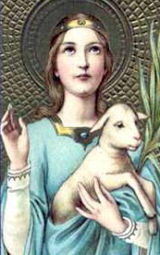It has become the custom in our family to read St. Agnes’s story from the book,57 Stories of Saints. It does a nice job of presenting young Agnes and her humility, holiness and faith. It also makes her gruesome death easier to read to children.

Here’s a shorter version from Catholic Online:
St. Agnes was a Roman girl who was only thirteen years old when she suffered martyrdom for her Faith. Agnes had made a promise, a promise to God never to stain her purity. Her love for the Lord was very great and she hated sin even more than death! Since she was very beautiful, many young men wished to marry Agnes, but she would always say, “Jesus Christ is my only Spouse.”Procop, the Governor’s son, became very angry when she refused him. He had tried to win her for his wife with rich gifts and promises, but the beautiful young girl kept saying, “I am already promised to the Lord of the Universe. He is more splendid than the sun and the stars, and He has said He will never leave me!” In great anger, Procop accused her of being a Christian and brought her to his father, the Governor. The Governor promised Agnes wonderful gifts if she would only deny God, but Agnes refused. He tried to change her mind by putting her in chains, but her lovely face shone with joy. Next he sent her to a place of sin, but an Angel protected her. At last, she was condemned to death. Even the pagans cried to see such a young and beautiful girl going to death. Yet, Agnes was as happy as a bride on her wedding day. She did not pay attention to those who begged her to save herself. “I would offend my Spouse,” she said, “if I were to try to please you. He chose me first and He shall have me!” Then she prayed and bowed her head for the death-stroke of the sword.
We made these cute little lambs last year to help commemorate the feast day.
I love this tradition on her feast day, and can’t wait to see Pope Francis with those sweet little lambs!
VATICAN CITY (CNS) — Certain things — such as a bath and getting dressed up — are universal before a personal meeting with the pope, and the rule holds even for lambs.
As he does every year, Pope Benedict XVI blessed two little lambs Jan. 21, the feast of St. Agnes.
Raised by Trappist monks on the outskirts of Rome, the lambs spent the night before their papal audience in the center of Rome on the rooftop terrace of the Sisters of the Holy Family of Nazareth.
L’Osservatore Romano, the Vatican newspaper, interviewed Holy Family Sister Hanna Pomnianowska about her convent’s role in the ancient tradition which makes a connection between the name of St. Agnes, an early Christian martyr, and “agnus,” the Latin word for lamb.
The wool of the lambs blessed on the feast day is woven by a different community of nuns and becomes the fabric for the “pallium,” a circular stole, which the pope gives each June to new archbishops from around the world.
Sister Pomnianowska said her order got involved in 1884 when a group of elderly sisters living nearby could no longer handle the task of preparing the lambs to attend a Mass and then be blessed by the pope.
She said that as soon as the Trappists arrive with the lambs, “we take them to the top floor of our house, where we have a large terrace and laundry room. As you can imagine, they are the joy of the entire community, especially of the younger sisters.”
“The first thing we do is wash them. We put them in a tub with baby soap to delicately wash the dirt away. Then we dry them. We used to use towels, but now we use a blowdryer. We are careful not to leave their skin damp because they are young and could get sick,” she said.
The baby lambs spend the night in the laundry room, in a covered pen filled with straw to keep them warm.
The morning of their big blessing day, she said, a decorative blanket is placed on each lamb. One blanket is red to recall St. Agnes’ martyrdom; the other is white to recall her virginity.
“Then we weave two crowns of flowers — one red and one white — and place them on their heads. And we tie bows around their ears,” she said.
After they are adorned, the lambs are placed in baskets, the sister said. “We are forced to bind them to prevent them from running away; once, in fact, I saw a lamb jump up and run from the altar.”
Once they are prepared, the lambs are taken to Rome’s Basilica of St. Agnes Outside the Walls, where they are placed on the altar over the martyr’s tomb and are blessed. Then Vatican workers arrive to take the lambs to the pope, she said.
The lambs are blessed again by the pope, usually in the Chapel of Pope Urban VIII in the apostolic palace, she said. The ceremony is attended by two of the Holy Family Sisters — usually two who are celebrating a significant anniversary of religious profession, she said.



